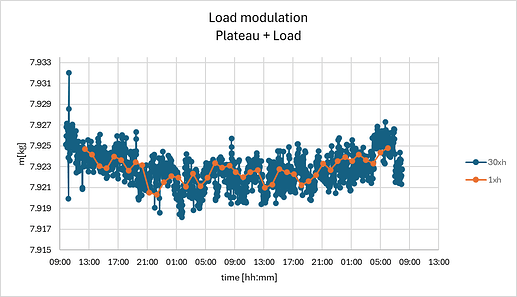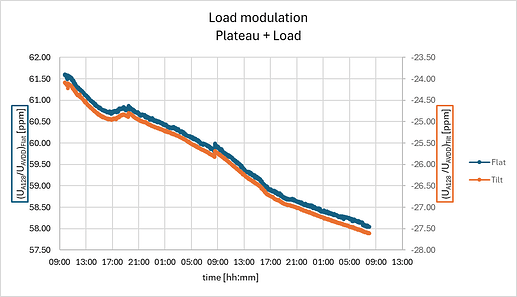Hi Mois and Henri,
Of course, more work needs to be done to mature the method and the set-up design, but I’m past hope for my application. Nevertheless I understand you may need more convincement before digging up these old bathroom scales from the back of your garage, although some help could speed-up the maturing process.
Here an update:
After some adaptations the set-up is able to cope with higher loads and have now a comparable drift-correction results to max 10 g (1.5 g standard deviation) over a period of 2 day while the uncorrected signal was drifting for 320 g with a load of 8 kg.
But there is also less good news, or to put it positive, there are more challenges:
-
During one test at higher load the high torque servo stopped operation after 1 h (30 tilt-cycles). I’m not sure this is due to the servo, the power supply or the way the servo positioning steps are controlled by my Arduino code. Fortunately I could recover the outage of the servo by switching off/on the power supply to the servo. I’m also not satisfied by the Servo library I’m using as it is too basic and is missing control over the move velocity. I followed a workaround to control the move-speed by splitting the servo-move in smaller steps with some delay in between, but I think to hear the servo is not liking this at all positions it passes. Furthermore, I consider to use some levers to reduce the load on the servo.
-
The servo with power supply consume quite some energy in the order of 300 Wh per day at 30 tilt-cycles per h and 100 Wh per day at 3 tilt-cycles per h. For my application less of an issue but for off grid operation this may claim higher energy storage and generation capacity. To save energy I’ve tried to reduce the tilting frequency from 30x to 3x per hour at the cost of missing out some ‘high’ frequent drift. First result show it is still quite ok increase the drift by 50%. I think there might be some room to reduce the tilt frequency even further.
I’m open for tips and tricks and any other suggestions.
Regards, Geert

